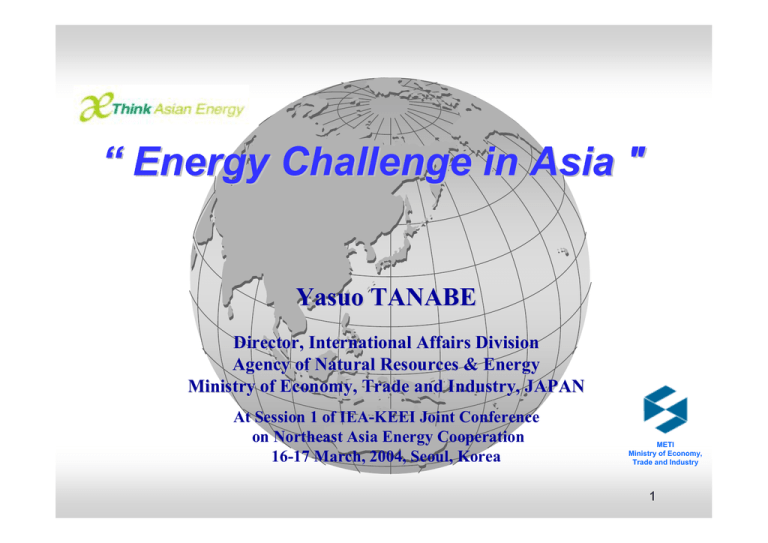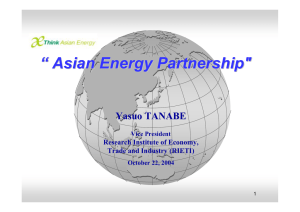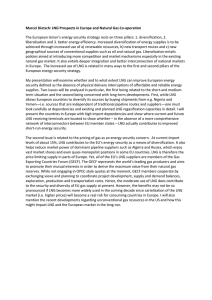“ Energy Challenge in Asia " Yasuo TANABE
advertisement

“ Energy Challenge in Asia " Yasuo TANABE Director, International Affairs Division Agency of Natural Resources & Energy Ministry of Economy, Trade and Industry, JAPAN At Session 1 of IEA-KEEI Joint Conference on Northeast Asia Energy Cooperation 16-17 March, 2004, Seoul, Korea METI Ministry of Economy, Trade and Industry 1 Contents 1. Energy Challenge in Asia 2. Energy Situation in Asia 3. Issues to be addressed 3-1. Oil Market 3-2. Energy Data 3-3. Oil Stockpile 3-4. Natural Gas 3-5. Coal 3-6. Energy Efficiency / Renewable 4. Russian Projects 5. Forum, Dialogue & Cooperation 6. Japan’s Energy Policy Review 2 1. Energy Challenge in Asia Energy Demand/Supply Situation - Rapid Growth of Energy Demand in Asia - Increasing Dependence on Imported Energy (especially oil from the Middle East countries) Challenge: Energy Security - “Energy Security” in the broader sense: - Secure stable supply of energy at a reasonable cost in an environmentally friendly manner Enhancement of Asian Energy Security 3 2. Energy Situation in Asia 1. Major Focal Point of Growing Demand in the International Energy Market 2. IEA Members (Japan and Korea) & Non-members (China, ASEAN and so on) 3. Indigenous Natural Gas & Oil Resources (China, Russia<East Siberia & Sakhalin>, and ASEAN producing countries) 4 World Primary Energy Supply Outlook by Region Growing Energy Demand in Asia Region Middle East Mtoe 15,267 Africa 16000 5% 13,167 14000 5% 4% 5% 11,132 12000 4% 3% 5% 9,179 10000 4% 3% 4% 8000 6% 13% China 14% 12% 10% 11% 11% Transition Economies 11% 4000 40% 43% 47% 51% Latin Am. America Asia 20% 19% 19% 17% 11% 6000 5% OECD 2000 Excluding Japan & Korea 0 2000 2010 2020 2030 Source: IEA/World Energy Outlook 2002 5 Natural Gas Reserves, Oil & Gas Projects in the Region >Recent Projects >Natural Gas Reserves Gas Producing Countries Proved Reserves (TCF) Share of total (%) PL Project from Russia <East Siberia & Sakhalin> WestWest-East Gas PL Project Fujian LNG Terminal Brunei 13.8 0.3 China 53.3 1.0 Indonesia 92.5 1.7 Malaysia 75.0 1.4 Australia 90.0 1.6 1680.0 30.5 Russia (including Sakhalin) Guandong LNG Terminal Malaysia: Tiga LNG To Potential Buyers Indonesia: Tangguh LNG Source: BP Statistics 2003 Australia: NWS 6 LNG 3. Issues to be addressed METI Ministry of Economy, Trade and Industry 7 3-1. Oil Market -Collective Asian demand should have market power vis-à-vis suppliers >Establishing Oil Market in Asia -Establishment of more open and transparent Asian Oil Market will create better price mechanism and supply-demand balance. “Asian premium” is… the situation that the price of oil which the Middle East exports to Asia is higher by $1 ∼ $1.5 than that to Europe and U.S.A. Price( $/B) 28 Gap AL Formula price To Asia To Europe To U.S . 26 24 22 of price( $/B) 2.0 1.8 Premium(Average) 1.6 0.94$/B 1.4 20 1.2 18 1.0 16 0.8 14 0.6 12 0.4 Premium T o Asia - T o Europe 10 0.2 8 0.0 1 7 1991 1 7 1992 1 7 1993 1 7 1994 1 7 1995 1 7 1996 1 7 1997 1 7 1998 1 7 1999 1 7 2000 1 7 2001 8 3-2. Energy Data -To make the energy market function appropriately and to make a right energy policy -Energy data / Statistics fundamental -Harmonization, level up quality (accuracy, timeliness, coverage) -Capacity building <Example: Joint Oil Data Initiative (JODI) > 9 3-3. Oil Stockpile Japan & Korea Keeping national oil stockpiling= IEA members China China Decided to establish national oil stockpiling ASEAN Decided to revise ”ASEAN Petroleum Security Agreement” (1986) Planning to enhance regional emergency preparedness capability (2003). Considering the continuous increase of Energy demand in Asia, as an Emergency Response Measure, Establishment of Oil Stockpiling and regional cooperation in Asia is important. 10 3-4. Natural Gas >Recent Features in LNG Trade Diversification of LNG market - Increase of LNG suppliers and consumers (China, etc) - Increase of flexible contracts, spot transaction, swaps between seasons, etc. >Natural Gas Development in Northeast Asia Kovikta Gas PL >World LNG Trade Asia’s Total Share: 69% Sakhalin Gas PL South Korea 16% WestWest-East Gas PL Taiwan 5% North & South America 5% Europe 26% LNG LNG LNG LNG LNG Japan 48% Source: BP Statistics 2003 11 3-5. Coal Primary Energy Consumption in Asia Comparison of CO2 Emission per Calorie 90.6 71.5 49.5 Coal Oil Source: METI Natural Gas Natural Gas Hydraulic Nuclear Oil Coal (g-CO2/MJ) >Coal will remain as major energy source in Asia till 2020. >Emission of CO2 by consumption of Coal is almost double of Natural Gas Source: Institute of Energy Economics, Japan “Clean Coal Technology (CCT)” will contribute to… ¾Reduction of Environmental Load. ¾Effective Usage for other fossil fuels using coal as relatively rich resource. 12 3-6. Energy Efficiency & Renewable In Asia, each country shows different index on how much efficient in energy use. Total Primary Energy Supply per GDP 2001 TOE/MUS$@1995 1.2 1 >Some countries have own technology and experience in efficient energy use. >Possibility on cooperation to share those technology and experience in Asian countries. 0.8 0.6 0.4 0.2 0 China Korea Asia Total Japan Source: Energy Balance of OECD/Non-OECD Countries, IEA 2003 And also, >Renewable energy (hydro, solar, wind, geothermal, combustion, biomass, etc) to successfully deal with environment problems and energy security, >Further cooperation of renewable energy policy in Asian countries . 13 4. Russian Projects 4-1. Sakhalin Projects Sakhalin-1 Sakhalin-2 Sakhalin-1 Sakhalin-2 Recoverable Reserves Grand Project Cost Schedule Oil: approx.2.3 Billion BBL Oil: approx.1.1 Billion BBL Gas: approx. 17TCF Gas: approx. 17TCF 12 Billion USD 10 Billion USD 2005: Commencement of Oil Production Max. 250,000B/D 1999: Commencement of Oil Production Max. 180,000B/D 2008: Commencement of Natural Gas by pipeline *planning 2007: Commencement of Natural Gas by LNG *planning Max. 9.6MMt/yr Max. 6MMt/yr Length: 1,3001,300-1,600km Source: Report from related companies 14 4-2. East Siberia Oil Development and Pipeline Project - Route: - Length: - Capacity: - Estimated Construction Cost: - Status: From Angarsk to Nakhodka 3,885km 1MMB/D approx. 6 billion USD Under consideration by Russian Gov. Source: Publication from Transneft PL Project from Russia<East Siberia & Sakhalin> Sakhalin Angarsk Nakhodka 15 5. Forum, Dialogue & Cooperation METI Ministry of Economy, Trade and Industry 16 Bilateral Fora between Japan & other Asia Region Countries - Republic of Korea On 19 March 2004: The 12th Korea-Japan Energy Policy Dialogue will be held. - People’s Republic of China On 23 October 2003: The 7th China-Japan Energy Policy Dialogue. - Australia In May 2004: The 28th Australia-Japan High Level Group on Energy and Minerals Consultations will be held. - Russian Federation Under Planning 3rd Russia-Japan Energy Policy Dialogue 17 Multilateral Energy Forum ►ASEAN + 3 (Japan, China, and Korea) Energy Cooperation - Priority areas (from “HIRANUMA Initiative”, September 2002) * Creation of an emergency network * Initiative for the development of oil stockpiling * Development of joint studies on the Asian oil market * Initiative for the improvement of natural gas development * Initiative for the improvement of energy efficiency and renewable energy - Natural Gas Forum, to be held in Shanghai in 29-30 March 2004 18 Multilateral Energy Forum ► APEC Energy Cooperation “Energy Security Initiative” (from 2000) * Monthly oil data collection * Energy information sharing, etc. ► IEF (The International Energy Forum) - 8th Forum achievements (September, 2002) * Confirmation of collaboration between oil-producing and oil consuming countries toward stabilization of the oil market * Support for Joint Oil Data Initiative (JODI) (Priority: M-1 Data on production, stocks, and demand) * Sharing awareness of the energy supply-demand situation in Asia * Confirmation of the importance of natural gas * Agreement to set up a permanent secretariat - 9th Forum: Amsterdam, May 2004 19 6. Japan’s Energy Policy Review Japan’s Energy Policy including long-term outlook is under review. Related Points: 1.Asian Regional Approach 2. Natural Gas Shift 3. Oil Market in Asia 4. Energy / Environment Integrated Policy 20




